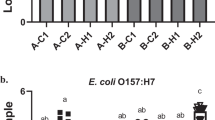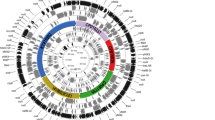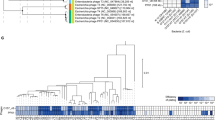Abstract
The persistence of food-borne pathogens in soil can trigger disease outbreaks, highlighting the critical need to understand their survival patterns. Here we investigate the survival of Escherichia coli O157:H7, a notable food-borne pathogen, across 81 natural soils from eastern China using inoculation experiments. E. coli O157:H7 survival ranged from 2.0 days to 43.3 days in soils. The survival-time map revealed hotspots and geographical heterogeneity of E. coli O157:H7 survival across eastern China. Bioinformatics analysis and validation experiments identified available phosphorus as the major factor controlling E. coli O157:H7 survival, with higher available phosphorus content in soils extending their survival. Two opportunistic pathogens, Enterococcus faecium and Aerococcus viridans, facilitated E. coli O157:H7 survival by forming biofilm structures and cross-feeding, respectively. Climate factors showed mostly indirect correlations with E. coli O157:H7. These findings enhance our understanding of food-borne pathogen survival in soils and offer insights to inform agricultural practices for preventing and controlling outbreaks.
This is a preview of subscription content, access via your institution
Access options
Access Nature and 54 other Nature Portfolio journals
Get Nature+, our best-value online-access subscription
$32.99 / 30 days
cancel any time
Subscribe to this journal
Receive 12 digital issues and online access to articles
$119.00 per year
only $9.92 per issue
Buy this article
- Purchase on SpringerLink
- Instant access to full article PDF
Prices may be subject to local taxes which are calculated during checkout





Similar content being viewed by others
Data availability
The sequence data that support the findings of this study are available in the NCBI database as PRJNA1030546. Source data are provided with this paper.
Code availability
No custom code was developed for use in this paper. Code used for statistical analyses in this study is available via GitHub at https://github.com/zhangnan1997/Geographic-heterogeneity-and-drivers-of Escherichia-coli-O157-H7-survival-in-soils.
References
Baker, R. E. et al. Infectious disease in an era of global change. Nat. Rev. Microbiol. 20, 193–205 (2021).
Li, M. et al. Natural host–environmental media–human: a new potential pathway of COVID-19 outbreak. Engineering 6, 1085–1098 (2020).
Levy, J. I., Andersen, K. G., Knight, R. & Karthikeyan, S. Wastewater surveillance for public health. Science 379, 26–27 (2023).
Raymenants, J. et al. Indoor air surveillance and factors associated with respiratory pathogen detection in community settings in Belgium. Nat. Commun. 14, 1332 (2023).
Zhu, D., Zhang, Y. & Zhu, Y. Human pathogens in the soil ecosystem: occurrence, dispersal, and study method. Curr. Opin. Environ. Sci. Health 33, 100471 (2023).
Samaddar, S. et al. Role of soil in the regulation of human and plant pathogens: soils’ contributions to people. Philos. Trans. R. Soc. B 376, 20200179 (2021).
Todd-Searle, J. et al. Quantification of Salmonella enterica transfer between tomatoes, soil, and plastic mulch. Int. J. Food Microbiol. 316, 108480 (2020).
Alegbeleye, O. & Sant’Ana, A. S. Survival of Salmonella spp. under varying temperature and soil conditions. Sci. Total Environ. 884, 163744 (2023).
van Elsas, J. D., Semenov, A. V., Costa, R. & Trevors, J. T. Survival of Escherichia coli in the environment: fundamental and public health aspects. ISME J. 5, 173–183 (2011).
Liu, B. et al. Enterohaemorrhagic E. coli utilizes host- and microbiota-derived l-malate as a signaling molecule for intestinal colonization. Nat. Commun. 14, 7227 (2023).
Rangel, J. M., Sparling, P. H., Crowe, C., Griffin, P. M. & Swerdlow, D. L. Epidemiology of Escherichia coli O157:H7 outbreaks, United States, 1982–2002. Emerg. Infect. Dis. 11, 603–609 (2005).
Anderson, J. D. et al. Burden of enterotoxigenic Escherichia coli and shigella non-fatal diarrhoeal infections in 79 low-income and lower middle-income countries: a modelling analysis. Lancet. Glob. Health 7, e321–e330 (2019).
Khalil, I. A. et al. Morbidity and mortality due to shigella and enterotoxigenic Escherichia coli diarrhoea: the Global Burden of Disease Study 1990–2016. Lancet Infect. Dis. 18, 1229–1240 (2018).
Interagency Food Safety Analytics Collaboration. Foodborne Illness Source Attribution Estimates for Salmonella, Escherichia coli O157, and Listeria monocytogenes—United States 2021 Annual Report (Centers for Disease Control and Prevention, 2023).
Rodwell, E. V., Greig, D. R., Godbole, G. & Jenkins, C. Clinical and public health implications of increasing notifications of LEE-negative Shiga toxin-producing Escherichia coli in England, 2014–2022. J. Med. Microbiol. 73, 001790 (2024).
Jones, G. et al. Sporadic Shiga toxin-producing Escherichia coli-associated pediatric hemolytic uremic syndrome, France, 2012–2021. Emerg. Infect. Dis. 29, 2054 (2023).
Bai, X. et al. Prevalence and characteristics of Shiga toxin-producing Escherichia coli isolated from retail raw meats in China. Int. J. Food Microbiol. 200, 31–38 (2015).
Banerjee, S. & van der Heijden, M. G. A. Soil microbiomes and one health. Nat. Rev. Microbiol. 21, 6–20 (2023).
Mohanapriya, R., Paranidharan, V., Karthikeyan, S. & Balachandar, D. Surveillance and source tracking of foodborne pathogens in the vegetable production systems of India. Food Control 162, 110427 (2024).
Işık, S., Çetin, B. & Topalcengiz, Z. Transfer of Salmonella, Escherichia coli O157:H7 and Listeria monocytogenes from contaminated soilless substrate and seeds to microgreens. Int. J. Food Microbiol. 414, 110612 (2024).
Wang, H. et al. A glimpse of Escherichia coli O157:H7 survival in soils from eastern China. Sci. Total Environ. 476-477, 49–56 (2014).
Han, Z. et al. Disentangling survival of Escherichia coli O157:H7 in soils: from a subpopulation perspective. Sci. Total Environ. 749, 141649 (2020).
Meyers, B. C. & McLellan, S. L. Influence of nutrients and the native community on E. coli survival in the beach environment. Appl. Environ. Microbiol. 88, e0104322 (2022).
Zhang, N. et al. Indigenous microbial community governs the survival of Escherichia coli O157:H7 in constructed wetlands. J. Environ. Manage. 334, 117524 (2023).
Liang, C. et al. Sediment pH, not the bacterial diversity, determines Escherichia coli O157:H7 survival in estuarine sediments. Environ. Pollut. 252, 1078–1086 (2019).
Xing, J., Wang, H., Brookes, P. C., Salles, J. F. & Xu, J. Soil pH and microbial diversity constrain the survival of E. coli in soil. Soil Biol. Biochem. 128, 139–149 (2019).
van Elsas, J. D. et al. Survival of genetically marked Escherichia coli O157:H7 in soil as affected by soil microbial community shifts. ISME J. 1, 204–214 (2007).
Wang, H. Z. et al. Response of Escherichia coli O157:H7 survival to pH of cultivated soils. J. Soils Sediments 14, 1841–1849 (2014).
Yao, Z. et al. Survival of Escherichia coli O157:H7 in soils from vegetable fields with different cultivation patterns. Appl. Environ. Microbiol. 79, 1755–1756 (2013).
Yao, Z., Yang, L., Wang, H., Wu, J. & Xu, J. Fate of Escherichia coli O157: H7 in agricultural soils amended with different organic fertilizers. J. Hazard. Mater. 296, 30–36 (2015).
Zhang, T., Hu, S. & Yang, W. Variations of Escherichia coli O157:H7 survival in purple soils. Int. J. Environ. Res. Public Health 14, 1246 (2017).
Xiong, Y. W. et al. A novel Escherichia coli O157:H7 clone causing a major hemolytic uremic syndrome outbreak in China. PLoS ONE 7, e36144 (2012).
Yang, C. et al. Outbreak dynamics of foodborne pathogen Vibrio parahaemolyticus over a seventeen year period implies hidden reservoirs. Nat. Microbiol. 7, 1221–1229 (2022).
Palmer, J. S., Hough, R. L., West, H. M. & Avery, L. M. A review of the abundance, behaviour and detection of clostridial pathogens in agricultural soils. Eur. J. Soil Sci. 70, 911–929 (2019).
Muloi, D. M. et al. Population genomics of Escherichia coli in livestock-keeping households across a rapidly developing urban landscape. Nat. Microbiol. 7, 581–589 (2022).
van Elsas, J. D. et al. Microbial diversity determines the invasion of soil by a bacterial pathogen. Proc. Natl Acad. Sci. USA 109, 1159–1164 (2012).
Van Mooy, B. A. S. et al. Phytoplankton in the ocean use non-phosphorus lipids in response to phosphorus scarcity. Nature 458, 69–72 (2009).
Oliverio, A. M. et al. The role of phosphorus limitation in shaping soil bacterial communities and their metabolic capabilities. mBio 11, 01718–01720 (2020).
Chen, J. et al. Microbial phosphorus recycling in soil by intra- and extracellular mechanisms. ISME Commun. 3, 135 (2024).
Mallon, C. A. et al. The impact of failure: unsuccessful bacterial invasions steer the soil microbial community away from the invader’s niche. ISME J. 12, 728–741 (2018).
Su, M. et al. Phosphorus deficiency in soils with red color: insights from the interactions between minerals and microorganisms. Geoderma. 404, 115311 (2021).
Spohn, M. & Schleuss, P. Addition of inorganic phosphorus to soil leads to desorption of organic compounds and thus to increased soil respiration. Soil Biol. Biochem. 130, 220–226 (2019).
Dal Bello, M., Lee, H., Goyal, A. & Gore, J. Resource–diversity relationships in bacterial communities reflect the network structure of microbial metabolism. Nat. Ecol. Evol. 5, 1424–1434 (2021).
Cossart, P. & Sansonetti, P. J. Bacterial invasion: the paradigms of enteroinvasive pathogens. Science 304, 242–248 (2004).
Huus, K. E. et al. Cross-feeding between intestinal pathobionts promotes their overgrowth during undernutrition. Nat. Commun. 12, 6860 (2021).
Semenec, L. et al. Cross-protection and cross-feeding between Klebsiella pneumoniae and Acinetobacter baumannii promotes their co-existence. Nat. Commun. 14, 702 (2023).
Dong, J. et al. The coexistence of bacterial species restructures biofilm architecture and increases tolerance to antimicrobial agents. Microbiol. Spectr. 11, e0358122 (2023).
Chitlapilly Dass, S. et al. Impact of mixed biofilm formation with environmental microorganisms on E. coli O157:H7 survival against sanitization. npj Sci. Food 4, 16 (2020).
Zhou, X. et al. Cross-kingdom synthetic microbiota supports tomato suppression of Fusarium wilt disease. Nat. Commun. 13, 7890 (2022).
Suleiman, A. K. A. et al. Temporal variability of soil microbial communities after application of dicyandiamide-treated swine slurry and mineral fertilizers. Soil Biol. Biochem. 97, 71–82 (2016).
Jiao, S., Yang, Y., Xu, Y., Zhang, J. & Lu, Y. Balance between community assembly processes mediates species coexistence in agricultural soil microbiomes across eastern China. ISME J. 14, 202–216 (2020).
Ma, J., Ibekwe, A. M., Crowley, D. E. & Yang, C. Persistence of Escherichia coli O157:H7 in major leafy green producing soils. Environ. Sci. Technol. 46, 12154–12161 (2012).
Mafart, P., Couvert, O., Gaillard, S. & Leguerinel, I. On calculating sterility in thermal preservation methods: application of the Weibull frequency distribution model. Int. J. Food Microbiol. 72, 107–113 (2002).
Baumgart, M. et al. Culture independent analysis of ileal mucosa reveals a selective increase in invasive Escherichia coli of novel phylogeny relative to depletion of Clostridiales in Crohn’s disease involving the ileum. ISME J. 1, 403–418 (2007).
McLellan, S. L. et al. Universal microbial indicators provide surveillance of sewage contamination in harbours worldwide. Nat. Water 2, 1061–1070 (2024).
Kulkarni, O. S. et al. Volatile methyl jasmonate from roots triggers host-beneficial soil microbiome biofilms. Nat. Chem. Biol. 20, 473–483 (2024).
Yang, X. et al. Loss of microbial diversity weakens specific soil functions, but increases soil ecosystem stability. Soil Biol. Biochem. 177, 108916 (2023).
Chen, S., Zhou, Y., Chen, Y. & Gu, J. fastp: an ultra-fast all-in-one FASTQ preprocessor. Bioinformatics 34, i884–i890 (2018).
Li, D., Liu, C., Luo, R., Sadakane, K. & Lam, T. MEGAHIT: an ultra-fast single-node solution for large and complex metagenomics assembly via succinct de Bruijn graph. Bioinformatics 31, 1674–1676 (2015).
Lu, J. et al. Metagenome analysis using the Kraken software suite. Nat. Protoc. 17, 2815–2839 (2022).
Bowers, R. M. et al. Minimum information about a single amplified genome (MISAG) and a metagenome-assembled genome (MIMAG) of bacteria and archaea. Nat. Biotechnol. 35, 725–731 (2017).
Lu, J., Breitwieser, F. P., Thielen, P. & Salzberg, S. L. Bracken: estimating species abundance in metagenomics data. PeerJ Comput. Sci. 3, e104 (2017).
Hyatt, D. et al. Prodigal: prokaryotic gene recognition and translation initiation site identification. BMC Bioinformatics 11, 119 (2010).
Fu, L., Niu, B., Zhu, Z., Wu, S. & Li, W. CD-HIT: accelerated for clustering the next-generation sequencing data. Bioinformatics 28, 3150–3152 (2012).
Qian, L. et al. MCycDB: a curated database for comprehensively profiling methane cycling processes of environmental microbiomes. Mol. Ecol. Resour. 22, 1803–1823 (2022).
Tu, Q., Lin, L., Cheng, L., Deng, Y. & He, Z. NCycDB: a curated integrative database for fast and accurate metagenomic profiling of nitrogen cycling genes. Bioinformatics 35, 1040–1048 (2019).
Zeng, J. et al. PCycDB: a comprehensive and accurate database for fast analysis of phosphorus cycling genes. Microbiome 10, 101 (2022).
Ge, Z. B. et al. Two-tiered mutualism improves survival and competitiveness of cross-feeding soil bacteria. ISME J. 17, 2090–2102 (2023).
Acknowledgements
We are grateful for the financial support of the National Natural Science Foundation of China (grant numbers 41721001 to J. Xu, 423B2701 to N.Z. and 42090060 to B.M.). We thank X. Zhao, X. Zhang, X. Zheng and X. Yu of the Analysis Center of Agriculture, Life and Environment Sciences, Zhejiang University, for their technical assistance.
Author information
Authors and Affiliations
Contributions
J. Xu acquired funding and contributed to the experimental design, study supervision, soil collection, interpretation of the results, and writing, review and editing. N.Z. acquired funding and contributed to the writing, data analysis, figure visualization and validation experiments. Z.Y. contributed to the soil collection and physicochemical characterization. T.Z. contributed to the soil collection and physicochemical characterization. J. Xing contributed to the investigation and formal analysis. H.W. contributed to the review. Z.J. contributed to the investigation. R.A.D. contributed to the review and editing. B.M. acquired funding and contributed to the soil collection, data analysis and review.
Corresponding author
Ethics declarations
Competing interests
The authors declare no competing interests.
Peer review
Peer review information
Nature Food thanks Peng Cai, Jincai Ma and the other, anonymous, reviewer(s) for their contribution to the peer review of this work.
Additional information
Publisher’s note Springer Nature remains neutral with regard to jurisdictional claims in published maps and institutional affiliations.
Supplementary information
Supplementary Information
Supplementary Text 1–5, Tables 1–8 and Figs. 1–8.
Source data
Source Data Figs. 1–5
Source data for Figs. 1–5.
Rights and permissions
Springer Nature or its licensor (e.g. a society or other partner) holds exclusive rights to this article under a publishing agreement with the author(s) or other rightsholder(s); author self-archiving of the accepted manuscript version of this article is solely governed by the terms of such publishing agreement and applicable law.
About this article
Cite this article
Xu, J., Zhang, N., Yao, Z. et al. Available phosphorus and opportunistic pathogens drive geographic variation in Escherichia coli O157:H7 survival in soils across eastern China. Nat Food 6, 777–786 (2025). https://doi.org/10.1038/s43016-025-01191-2
Received:
Accepted:
Published:
Issue date:
DOI: https://doi.org/10.1038/s43016-025-01191-2
This article is cited by
-
Soil drivers of food-borne pathogen persistence
Nature Food (2025)



